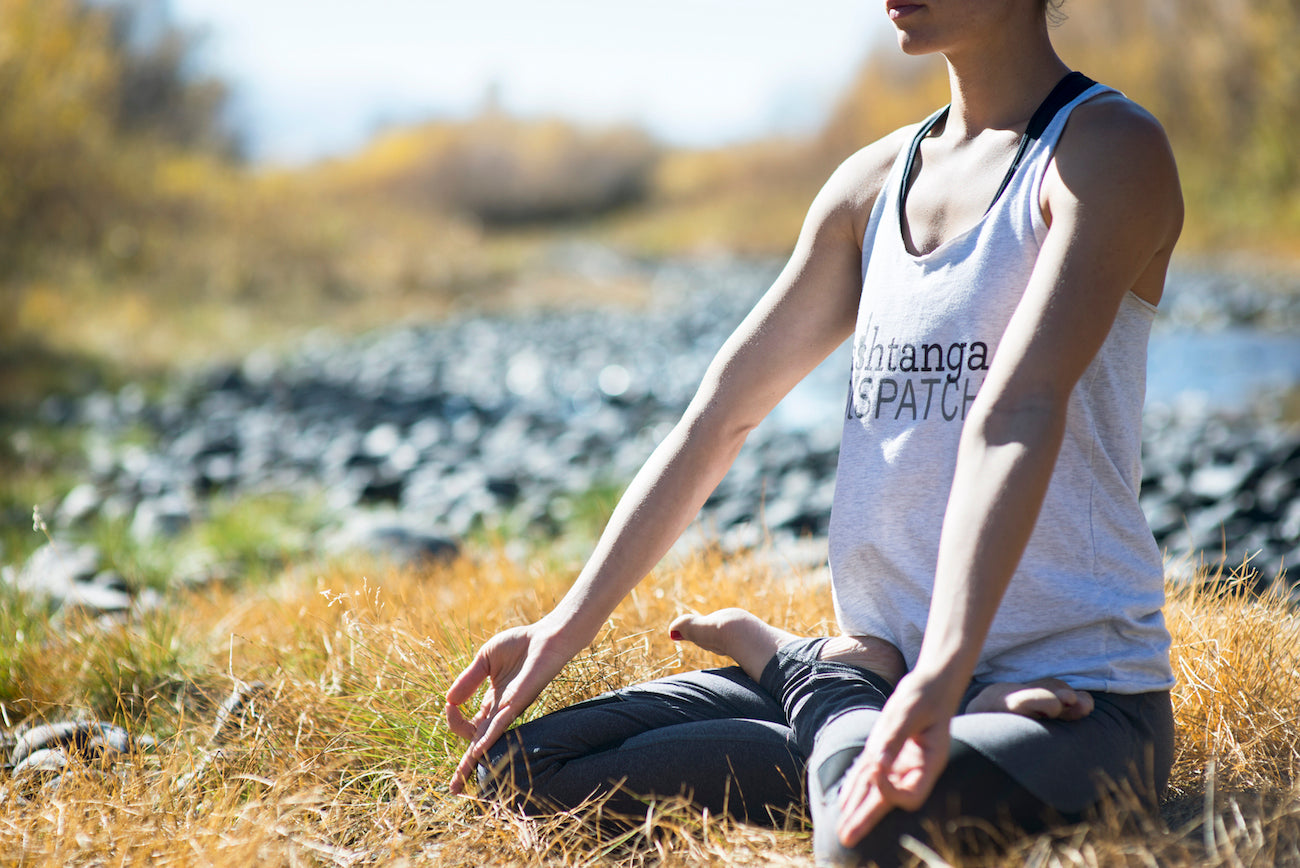Fall Equinox: An Ayurvedic perspective on transitioning into fall

Seasonal transition into Vata season
By Peg Mulqueen, Founder and host of Ashtanga Dispatch podcast
With October right around the corner, we begin to feel the rumblings of a new season. Ashtanga Dispatch Founder Peg Mulqueen has been studying and teaching yoga for the past two decades, and as an Ashtanga yoga enthusiast with a Masters degree in Psychology, Peg has always been drawn to the practice of change.
One of the biggest changes that affects us all, is the changing of the seasons. In this blog, Peg discusses the importance of transitioning with the seasons to allow new routines and the release of old ones to come more easily. With yoga being deeply rooted in Ayurveda, it is only natural that Peg would include HANAH products as part of her daily tips for flowing into Vata season.
In your element
According to Āyurveda, we were born with a combination of the same five essential elements (fire, water, earth, air, and space) found in all creation. These combinations make up our constitution or doṣha. Those with more fire are classified as Pitta. Those with more water and earth are Kapha. And those who contain more air and space are Vāta. While each of the doṣhas are present in everyone's makeup, one or two will likely be more predominant. Our doṣha does not change – but nearly everything else does and these outside changes can affect our balance. And perhaps no more felt are those changes than during the shift of seasons. For example, as summer temperatures rise, Pittas can overheat. The ground freezes in winter, and Kaphas may lose all motivation to ever leave the house. Or as the fall winds begin to blow, Vātas find themselves feeling scattered and spacey. Like now. Though remember, everyone is a combination of all three doṣhas. So no matter how much Vāta you have, it’s bound to become just a bit aggravated as autumn approaches. And why as the seasons change, now is the time to adopt a new rhythm of our own.

Ritu Sandhi: The space between
Āyurveda calls the transition between two seasons, Ritu Sandhi, or 'the place where seasons meet' – and offers specific healing practices and rituals to help prepare for the change, already in the air.
In autumn, this transition begins one week before the Fall Equinox and another seven days after. Though only two weeks long, it is a brief yet critical period of time in securing our health. The days are still warm but the nights are getting cooler. Leaves are turning colors but haven't yet fallen. Change is in the air – and yet, that change hasn't fully happened. Because seasons don't change overnight – nor should we. There is a process that is meant to be gradual. And for those living in the Western Hemisphere, that’s where we are, in the blurry space that is no longer summer and also, not yet fall.
Autumn: The winds of change
Vāta (or vayu) is a Sanskrit word that means wind. So not only does it contain the elements of air and space, but also other qualities we would associate with wind. It is cool dry, light, a bit brittle, and constantly moving and changing. Just like fall. And why Autumn is known as Vāta season. When in balance, Vāta is light and full of vitality, with an exuberance and dynamism that is utterly contagious. Which is especially useful for transitioning spring into summer. Vāta IS the breath of new life.
But, too much of anything is never a good thing. An excess of one means a void in another. Too much activity leads to not enough rest. Too much change leads to not enough stability. Too much excitement turns to anxiety, and a head always in the clouds leaves no place for roots. To stay balanced, we need more downward energy. We need the weight of water and the grounding of earth. Now is the time to exhale. We need more Kapha.

Seven ways to ease into fall
Here are seven simple ways you can incorporate Kapha-like qualities into your daily routine, which will help ease the transition to fall:
Tip #1: Slow down
The days grow cooler and the nights grow longer, inviting us to surrender. Rather than try and maintain the high energy of summer – now is the time to slow down and savor. In your yoga practice, this may mean less postures with longer more breaths. Walking may very well be the best exercise. Or consider taking up basket weaving. I hear it's a wonderful way to relax and refresh the brain.
Tip #2: Build strong roots
Vātas resist structure – but they need structure. And now more than ever. Because it's all too easy to get swept away by autumn winds – and why you need strong roots. Your roots are your routine. And your routine will help keep you grounded – no matter what the wind blows our way.
Tip #3: Eat natural
When it comes to deciding what to eat, use nature's harvest as your menu. Foods that are in season – like root vegetables, sweet potatoes, pumpkin, and squash – are all foods that are sweet, heavier, smooth, and more dense. These are Kapha qualities and will help pacify Vāta. And if you don't have a garden or a farm nearby, try joining a Community Supported Agricultural Program (CSA) where you can get local, chemical-free produce either delivered or available for pick up each week. We join one every winter and spring. Other foods include nuts, brown rice, oats, bananas, and ghee. Ghee is essential in fall as it is packed with essential fatty omega acids, it's dense and lubricating, and helps improve digestion. I put ghee in just about everything right now. Including this Kitchari recipe.
Tip #4: Add some spice
Herbs play a huge part in Āyurveda. Top of the list to pacify Vāta and increase Kapha are Ashwagandhā, Śhatāvari, Turmeric, and Āmalakī – all of which are in HANAH ONE. Which is good for me because most of the time, I can't be bothered to take all of them separately. So one spoonful in the morning is all I need. Other good herbs and spices to include as we move into fall are ginger, cinnamon, cardamom, and fennel. Tastes you'll want to avoid is anything bitter or astringent.
Tip #5: Care + nourish
Self care is vital for all seasons of the year. And using oils is one of my favorite ways to nourish myself, inside and out. Abhyañga is a self-massage you can do at home, preferably using a thicker oil like sesame, in the fall. Done a few hours after eating and at least an hour before taking a bath, warm the oil and then apply. I like to include earthy scents (especially now) like basil, rosemary, and clary sage. Self massage is warm, loving, and nourishing. It feels good. And you are worth it.
Tip #6: Maintain warmth
Around 11 am, after the heat of my practice has dissipated and I'm starting to lose steam, instead of reaching for coffee – I cook up this cup of goodness:
- An inch or so of fresh ginger, chopped
- 1 teaspoon Aṣhwagandha+
- 1 teaspoon Vechur Ghee
- 1 crushed cinnamon stick
- 10 ounces of milk (you can substitute in a nut milk instead)
Let simmer for about 30 minutes. Strain and pour. Add honey (though never cook the honey!) and sprinkle some turmeric on top. It's warm, nourishing, and the perfect pick-me-up on a chilly fall day.
Tip #7: Settle in
There are many ways to bring your focus in. Journaling is one way. Every morning, I sit and handwrite a few pages. Just a way to empty my mind and start the day fresh. But important for this time of year, journaling takes ideas and thoughts out of space and makes them tangible. Chanting is a beautiful and powerful practice, Through vibration and prayer, we can quiet the mind and open the heart. If that interests you, we have an introductory course beginning next month. An Introduction to Chanting || A 4-Week Online Course with Meghan Powell
Learn more about Astanga Dispatch and Founder Peg Mulqueen here.








Leave a comment
This site is protected by hCaptcha and the hCaptcha Privacy Policy and Terms of Service apply.